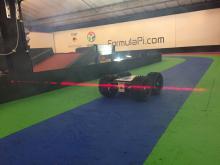Hello Everyone,
It's been a while, and I figured i'd check up on if the simulator I wrote so long ago is still in use, and what updates we could use if it is.
I've seen the upgrade from the yetiborgs to the monsterborgs, so I expect motor settings changes and the like. What I'd really like to fix up is streaming to be a proper hidden buffer to reduce some of the issues on smaller monitors.
I did make a small change as I open development again which cuts about 3ms off the image serve time on my machine along with fixing an out of memory issue (I let the sim run to about 12 hours with input from control code) from extended use.
Also I am much more comfortable with maven to handle the build / dependencies now which should hopefully solve some of the OS issues.
As a side question, is the Thunderborg i2cmapping the same as the zeroborg's?
Thanks,
Tim


Hi and welcome back! I thought the simulator had already been upgraded? Are you not involved with the 3D version being used for the virtual racing? We only got to see it for the first time a couple of days ago via the new intro video and haven't had access to be able to use it yet. They look very similar but the new version looks more advanced. So now I'm confused, which version do you mean?
I did not see that, you said it was in the new intro video a couple days ago? I'll have to check that out.
It would be cool to actually just focus on race code for once.
That looks pretty cool- looks like Arron has been busy adding some stuff to the original from long ago.
It does look very cool and I hope normal race teams get to try it out. I think it's whats being used for the virtual races mentioned this week. It is quite exciting but I don't know any more about it. I'll leave it to Arron or Tim to explain more.
The old simultor was very useful to get us started by the way. The process of transferring simulator success to the real life track has been a challenge but we've stuck to using the same general principles that were inspired by simulator testing right through to now. I don't think we'd be where we are now without it, so thank you for creating it.
Jon
I cannot take credit for the version of the simulator shown in the stream the other day, the improvements were made by someone else we know :)
I am not certain when we will start making use of the new simulator in Formula Pi, but I think we will be discussing the idea of virtual race rounds in the next season. As the footage shows we have been working on dynamic camera angles and scenery so that it will be entertaining to watch.
I think the biggest practical change for testing purposes is that we now have collision detection in the simulator. It should be good enough to know you made contact, but it does not accurately model what happens when robots collide...
As for the I2C mapping, the protocol is very similar but there are changes to the command codes and some of the functions. The most obvious changes are:
The Python library for the ThunderBorg with all the commands implemented can be found here.
Thanks for the update- I was honestly waiting till someone found the track editor I had in it and put that to use. I'm glad to see someone had been maintaining it in my absence.
Did physics / collision get figured out or is it still on the ghostyness that it used to have?
Thanks for the link on the motor control code, I'll end up wrapping it in a java library, and maybe depending on how much freetime my friend has (read: college student) who might compile up a native c++ library for the pi.
The latest version has a very basic collision detection that works well enough that you do get slowed down and you can push stationary robots out of the way :)
What it does not do very well is simulate getting stuck on the walls or other robots. There is also no flipping over in from running into something :D
I would say it is good enough to test avoidance code and see if it does actually collide with other robots. What it does not do is behave realistically when the collision does occur.
Add new comment